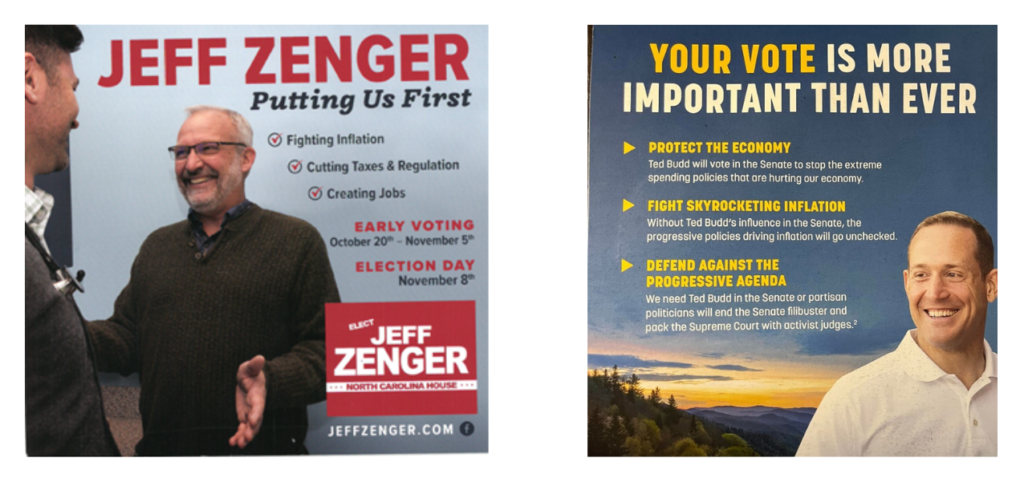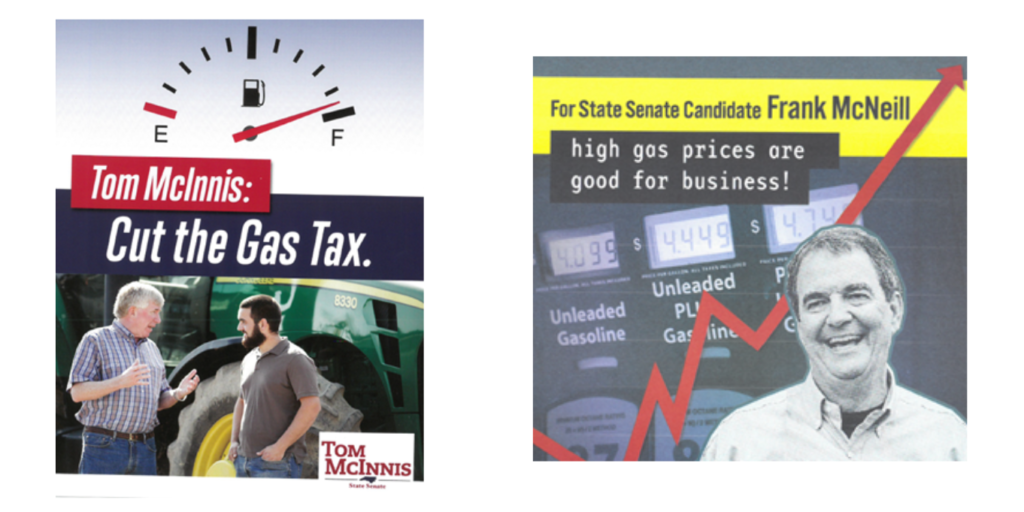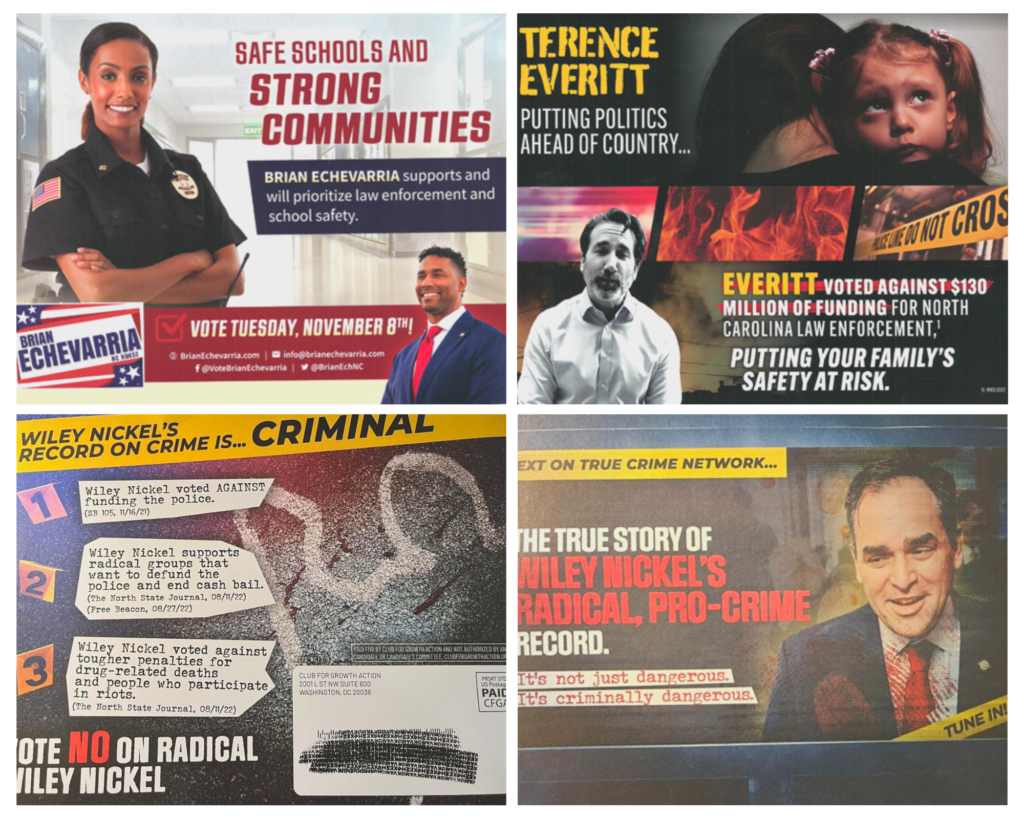Breaking Down North Carolina Election Messaging

by Kirk O’Steen, political director
For the last several weeks, voters have been bombarded with television ads, direct mailers, digital ads, and campaign materials ahead of the 2022 election. While many claim they don’t pay attention to, or actively avoid, political ads, I decided to embrace them, perhaps at the expense of my sanity. After looking through stacks of mailers and watching countless video ads, I have a few impressions of the most frequent messages used in North Carolina this cycle.
You Talkin to Me?
When we talk about campaign messaging, there are typically two categories that voters are sorted into, turnout voters and persuasion voters. Depending on the makeup of the electorate and overall political landscape, how a campaign talks to voters will change based on the number of “persuasion” voters vs. the number of “turnout” voters they anticipate.
Turnout Voters
Turnout voters are typically voters that have their minds made up. They have strong opinions, but not-so-strong voting records. The goal for these voters is to give them a reason to get so fired up, they feel they must go vote. Turnout messaging is very partisan and often some of the most negative campaigning material you will see.
Persuasion Voters
Persuasion voters require a softer touch. They are frequent voters, but they aren’t set on one party or another. Persuasion messaging usually involves words like “bipartisan,” “commonsense,” “moderate,” and other adjectives that suggest the candidate is not like those other politicians. The goal for these voters is that they remember the candidate’s name and have a positive association with it.
From the data we’ve seen this cycle and the historical precedent of midterms, this election will be about turnout, not persuasion. In fact, the number of persuadable or swing voters in North Carolina seems to be dwindling as our political discourse becomes more polarized. This means campaigns are relying more on strong partisan messages, rather than talking about togetherness and harmony. I think that’s an important thing to keep in mind as we get into the most common messaging themes this cycle.
Personal Attacks
Every election usually devolves into a mudslinging contest. I won’t include any of these ads here, but they play a large part in the information flow of a race. Campaigns spend thousands of dollars on opposition research in hopes that it will reveal the big scandal that will turn voters away from their opponent. This is always present in state and federal campaigns and this cycle is no different. While many cringe at these ads, it’s safe to say that they are effective to some degree, otherwise campaigns would not use them.
“It’s the economy, stupid!”
Despite the famous words of former Clinton advisor James Carville, talking about the economy isn’t usually the most effective message to motivate voters. In 2020, the most important issues for voters were COVID-19 response and general safety amidst a global pandemic. In 2018, education was top of mind for voters.

This year, inflation and the economy are consistently two of the biggest concerns for voters in North Carolina. Gas prices hit a new high in 2022, prices for goods are rising across the board, the stock market is sputtering, and there’s great uncertainty in the short-term economic outlook. This is probably the biggest message I have seen Republicans leveraging in competitive races.
With President Biden in the White House and a Democratic Congress, it’s easy for Republicans to draw a connection between our country’s leadership and the current economic woes. Historically speaking, the political parties of the president typically perform poorly if the economy is in bad shape. Additionally, voters trust Republican candidates more than Democrat candidates to handle economic issues. As a candidate, that’s exactly where you want your campaign messaging to be, at the intersection of voters’ concerns and their trust in your political party.

Given the recent surge for Republicans in the polls, I think these economic messages are proving to be effective as gas prices are rising again and many expect a tough winter.

Tough on Crime
In 2020, the “Defund the Police” movement started to gain traction in the more progressive circles of the Democratic party. While many moderate and vulnerable Democratic candidates distanced themselves from the movement in 2020, the conversation around diverting law enforcement funding has only grown in the last two years. This is another frequently used theme for Republicans. Many Republican candidates are presenting their opponents as “soft” on crime. To combat this message, I’ve seen many Democratic candidates going out of their way to show themselves as supportive of law enforcement and “tough” on crime. This positioning is definitely a contrast to what we saw from similar Democratic candidates in 2020. I’ll also note that crime and rule of law are issues that voters trust Republicans more to address so the shift makes sense.

Reproductive Rights
After the U.S. Supreme Court effectively overturned the Roe v. Wade precedent (Dobbs vs. Jackson Women’s Health Organization), the debate over abortion has shot into the spotlight of our political discourse. Democrats’ prospects were looking bleak behind a president who, at the time, had the lowest approval rating of any president at that point in their presidency. With the release of the Dobbs decision in late June, Democrats had a rallying cry to motivate disengaged liberal voters to get out and vote in the 2022 election. In North Carolina legislative races, this seems to be the biggest topic messaged by Democrats. Candidates are talking about codifying the Roe v. Wade precedent at a minimum. Additionally, I’ve seen several TV ads painting Republican candidates as extremists on the issue.

So What Does it Mean?
Democrats enjoyed a late summer surge in polling that was at least partly due to the Dobbs decision. Since then, however, Democratic prospects have cooled off and Republicans look to have momentum as we close in on the final two weeks of the election.

Timing is everything in politics and right now, time appears to be on Republicans’ side. As economic uncertainty grows, their messaging becomes more and more relevant. In the end, voters will have the final say on which candidates they prefer. Until then, we can only patiently wait for the results to come in on election night.
To learn more, or schedule a political briefing for your team, contact Kirk O’Steen.
